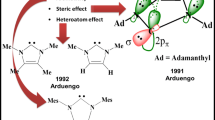Abstract.
Ab initio calculations on the lowest singlet and triplet states of 2,2-disilylcyclopentane-1,3-diyl find that the singlet lies well below the triplet. The C 2 singlet diradical is calculated to be a minimum on the potential energy surface with an enthalpic barrier to ring closure of ΔH ‡ 298 = 13.5 kcal/mol at the CASPT2/6-31G* level of theory. The energy of the 1,3-divinyl-substituted singlet diradical is calculated to be only 0.8 kcal/mol higher than that of 5,5-disilyl-1,3-divinylbicyclo[2.1.0]pentane at this level of theory, but the transition state for their equilibration is computed to be 12.8 kcal/mol above the diradical in energy.
Similar content being viewed by others
Author information
Authors and Affiliations
Additional information
Received: 2 July 1998 / Accepted: 4 August 1998 / Published online: 16 November 1998
Rights and permissions
About this article
Cite this article
Johnson, W., Hrovat, D., Skancke, A. et al. Ab initio calculations find 2,2-disilylcyclopentane-1,3-diyl is a singlet diradical with a high barrier to ring closure. Theor Chem Acc 102, 207–225 (1999). https://doi.org/10.1007/s002140050492
Issue Date:
DOI: https://doi.org/10.1007/s002140050492




